A comprehensive lesson on application in the second junior group on the topic “Wild Animals”
Maria Medvedeva
Complex lesson on application in the second junior group on the topic “Wild Animals”
Topic: “ Wild animals . Beautiful napkin"
Integration of educational areas: “Cognitive development”
,
“Speech development”
,
“Artistic and aesthetic development” (
application ) .
The goals of the teacher’s activities: to develop the ability to recognize, name and distinguish the features of the appearance and lifestyle of wild animals ; cultivate activity, independence, love for the animal world ; learn to make a pattern on square paper, placing large circles of the same color in the corners and in the middle, and small circles of a different color in the middle of each side.
Materials and equipment: pictures depicting wild and domestic animals , panel “Winter Forest”
applique sample , napkins, large and small circles cut from colored paper, square sheets of white paper, glue, brushes, napkins.
Craft Panda
Panda facts:
- Pandas are an endangered species.
- They eat about 28 pounds of bamboo a day!
- Adult pandas weigh about 300 pounds (136 kg).
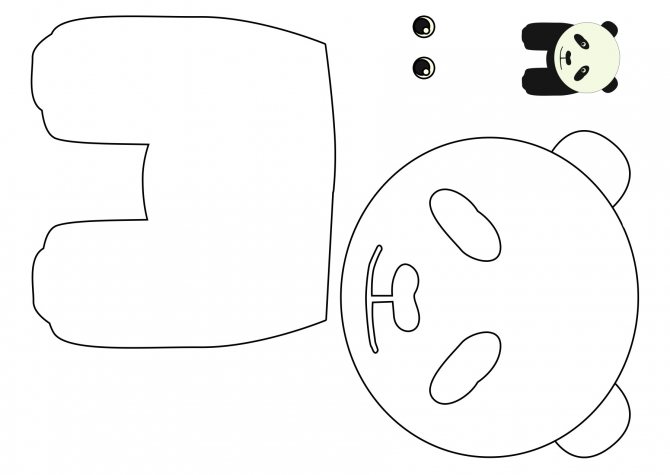
- Wild pandas live only in remote mountainous areas of China.
- Pandas are solitary animals.
Outline for the application “Wild Animals”
Semenova Tatyana Raisovna
Outline for the application “Wild Animals”
Topic: Wild animals .
– expand children’s knowledge about wild animals
– strengthen children’s ability to work with templates and trace along the contour.
– improve the ability to work with scissors.
– Continue to develop figurative, auditory, visual perception, thinking, attention and speech.
– develop gross and fine motor skills of the hands.
– cultivate the ability to plan one’s activities , accuracy in performing work, and perseverance.
– instill a friendly attitude towards the natural environment.
– develop the ability to work in a team, communication skills.
– review of the album “ Wild Animals ”
, conversation about
wild animals , reading fiction.
– showing children a shadow theater to familiarize themselves with the silhouettes of animals .
– creation of the composition “autumn forest”
.
Materials: Composition “Autumn Forest”
, colored woolen threads, scissors, glue, glue brushes, simple pencils, animal templates, napkins.
The group is decorated in an autumn forest.
1. Organizational moment
Guys, I suggest you go to the kingdom of wild animals . If we want to go to the kingdom, then we need transport, not simple, but magical. Let's go on a fabulous transport, let these be our chairs. We will say the magic words and our chairs will fly to the kingdom of wild animals .
1.2.3 - my chair fly! (children close their eyes and imitate moving their arms to the sides and land in the forest)
Here we are in the kingdom of wild animals . Admire the beauty of autumn trees, colorful leaves. We really entered the kingdom of wild animals .
1). We saw the tracks. Q: Guys, let's follow the tracks. Whose traces do you think these could be?
Bear. (bear growl)
What is that sound? Who makes this sound?
The teacher displays a picture of a bear and the children talk about the bear.
– What do you know about the bear? (One child tells and hangs it on a magnetic board)
.
2) We saw footprints again. Q: Whose footprints are these?
These are fox tracks. (fox cry)
Who makes this sound?
This is the sound made by a fox.
The teacher displays a picture of a fox and the children talk about the fox and hang it on a magnetic board).
3) We saw the tracks of a hare. Q: Whose tracks are these?
These are hare tracks because...
The teacher displays a picture of a hare and the children talk about the hare and hang it on a magnetic board.
4) whose traces are these?
These are the tracks of a wolf. (children guess whose howl)
The teacher displays a picture of a wolf and the children talk about it and hang it on the board)
5). Let's go, whose tracks are these?
These are squirrel tracks. (The sound of a squirrel, who makes this sound?
this sound is made by a squirrel. (children talk about the squirrel and post it on the board)
Guys, what animals did we meet ?
bear, wolf, fox, hare, squirrel - wild animals .
Q: Guys, what time of year is coming soon?
Winter. yes, winter. I suggest you dress wild animals in warm fur coats so that they do not freeze in winter.
Now let's get to work. Here on my table are colored threads and patterns of wild animals , choose which animal you wanted to dress . Have you thought about what color of thread you chose and why?
I chose the orange color of the threads because the fox has an orange coat...
In the middle of the lesson there is a warm-up game “To the Watering Place”
One day, along a forest path, animals walked to a watering hole (children calmly walk in a circle)
A little fox was sneaking behind the mother fox (sneaking on tiptoes)
A bear cub walked behind the mother bear (they waddle)
The baby squirrels jumped after the mother squirrel (they jump in a squat position)
Behind the mother hare are the slanting hares (jumping on straightened legs)
The she-wolf led the wolf cubs (walking on all fours)
All mothers and children want to get drunk (face in a circle, make a tongue movement and lap)
.
Who dressed the animal in a fur coat , we move it into the forest. (autumn forest leaf prepared in advance)
Where would you like to place your animal ?
Look what a beautiful picture of the forest it turned out to be!
Guys, we need to go back to kindergarten. We sat down on the chairs and said the magic words: 1.2.3 - my chair fly (close your eyes)
So we flew back to our kindergarten.
Children's master class on volumetric applique from natural material “Wild Animals” Master class on volumetric applique “Wild Animals” from natural material – fallen autumn leaves – was carried out by preparatory children.
Lesson summary “Wild animals of our area” Purpose: to familiarize children with the changes that have occurred in the life of forest animals with the arrival of winter. Objectives: To clarify children’s knowledge of where they spend the winter.
Summary of the lesson “Wild Animals” in the middle group Goal: to systematize and clarify children’s knowledge about wild animals. Objectives: Educational: learn to pronounce certain sounds, guess.
Craft Warthog
Facts about warthogs:
- The "spikes" and bumps on a warthog's face... those are warts!
- They are from the same family as the cute domestic pigs, although they look different.
- They have 4 tusks (although our template only shows two).

- They eat grass and plants and dig up roots and bulbs.
- They live for about 15 years.
- Warthogs can go for long periods without drinking water.
Lesson on appliqué in the second junior group “Zoo”
Natalia Tsygichko
Lesson on appliqué in the second junior group “Zoo”
Lesson on appliqué in the second junior group “ Zoo ”
Integration of educational areas: “Artistic creativity”
,
“Cognition”
,
“Communication”
,
“Socialization”
Purpose: to introduce children to the technique of cut appliqué .
Objectives: teach children to work using the cut appliqué ; expand children's knowledge about wild animals, the zoo ; cultivate activity, independence, love for the animal world.
Equipment: sheets of paper with an outline of a giraffe for each child, brown colored paper, brushes, glue; pictures of animals from hot countries; animal figurines, bag.
Lion clipping
Facts about lions:
- Lions live in groups called "prides".
- Male lions boast a mane, a large fringe that encircles their heads.
- Males defend the pride territory, which they clearly mark with the smell of their urine.
- Lionesses are hunters in a pride. They often work together to hunt antelope, zebra, wildebeest, zebra, etc.
- Most lions on earth live in Africa, although a very small population can be found in India's Gir Forest.
Piggy
Even a preschooler can handle such a simple craft. With the guidance of your parents, you can easily create a funny pig. By the way, such a craft can even be converted into a cap, because its shape allows this.

To work you will need:
- Cardboard or thick pink paper;
- Glue;
- Scissors;
- Felt pen.

Operating instructions:
- For the base you will need a pink paper cone. To fold a cone, you need to draw a circle and divide it into 2 halves, cutting out one of them;
- From this half of the circle you will need to form a cone, adjusting its thickness when gluing;
- The base is ready, now all that remains is the details. Ears, snout, tail and eyes are cut out from pink cardboard. The pupils can be drawn with a black felt-tip pen.
- All parts are glued to the piglet. Below you only need to draw on the mouth, and the craft is complete.
- If you thread a thin elastic band inside the craft, you will get a festive hat.
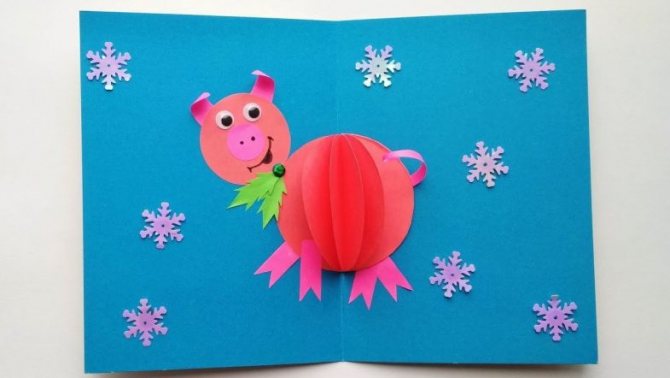
Fennec cutout
Fennec Fox Facts:
- The fennec fox is the smallest fox species in the world.
- They have huge bat-like ears that help radiate body heat and keep them cool in the desert.
- They mainly live in North Africa and the Sahara Desert.

- They have long hair, which keeps them warm on cold nights and protects them from the hot sun.
- They live in underground dens in small communities of about ten foxes.
- Fennec foxes are omnivores and eat both plants and small rodents, eggs, reptiles and insects.
- They can go without water for a long time.
Lamb
Since we are still learning how to make animal appliqué, crafts should be simple and require a minimum of materials. In addition, the templates can be downloaded from any source; all that remains is to cut out the necessary parts and glue them to the base.

Therefore, the next craft - a lamb - is also quite simple. And the animal template, printed and cut out, is taken as the basis.
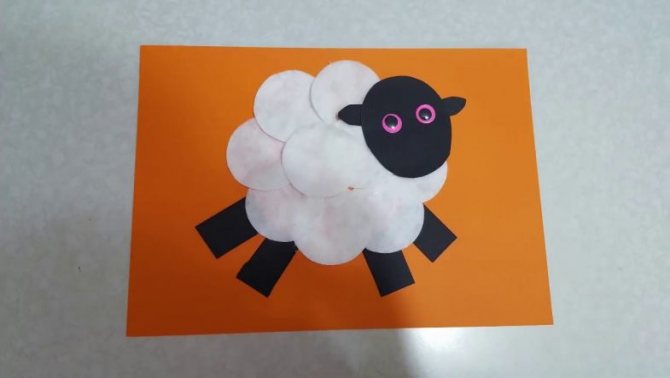
Additionally you will need:
- Glue;
- Scissors;
- Pasta or cotton wool to decorate the fur.
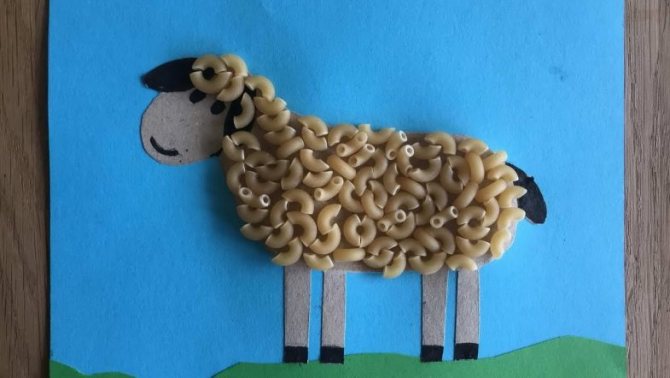
Operating instructions:
- The finished stencil is cut out of paper and pasted onto cardboard. You don’t have to stick it on the base, then the craft will turn out to be a contour;
- You can glue pasta in the form of curls to the place where the fur should be.
- You can glue cotton balls instead of pasta, then the craft will also turn out fluffy.

Hedgehog
The process of creating a hedgehog is similar to creating a lamb. Only instead of cotton wool or pasta, you will need to use buckwheat to create needles.

In addition to this, you will also need a cardboard base, glue and an animal stencil.
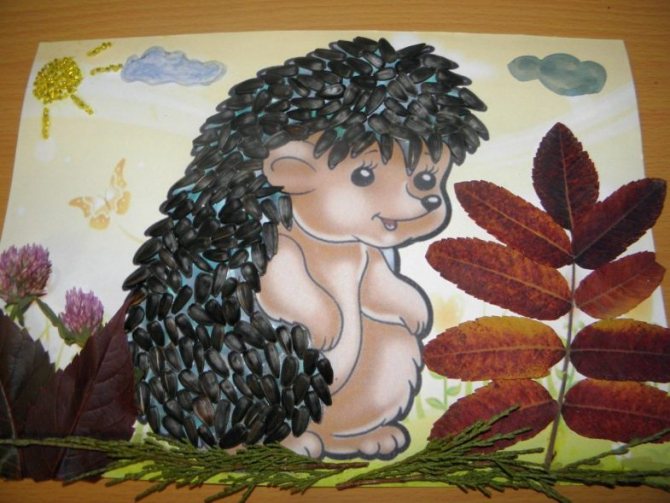
Operating instructions:
- You can draw a hedgehog yourself, or you can take a ready-made stencil and print it or redraw it onto a base;
- Next, you need to glue buckwheat to the place where the needles should be. The easiest way to do this is to carefully spread glue within the contour, and then pour in the cereal.
- As soon as the glue has hardened and the buckwheat has stuck, you need to carefully remove the un-glued remains. You can stick buckwheat dotted into empty spaces.
Howler monkey paper applique

Howler Monkey Facts:
- Howler monkeys live in tropical areas of Central and South America.
- They howl so loudly that they can be heard up to 5 km away.
- They have what is called a "prehensile" tail, which means they can use it as an extra hand to grasp branches.
- Howler monkeys can live 15-20 years in the wild.
Let's take a look into the treasury of the Internet...
I love finding useful materials in my favorite stores and sharing them with you, friends.
So, on our topic, “OZON.RU” offers many “useful things” for teachers and parents who want to teach children the art of appliqué.
There is a large selection of thematic literature and creativity kits: teaching aids, convenient kits with detailed instructions.
You can buy ready-made stickers and create your own application - both the youngest and older children will like it. They sell colorful books with entertaining stories, in the illustrations of which you can paste some element. By reading a book to your child, you simultaneously train his fine motor skills. Convenient and useful, isn't it?
To help educators and advanced parents, I offer training manuals from UchMag:
“Funny applique” by Y. Kozlova - here are 17 themes for applique classes in kindergarten and at home. The material is informative and interesting, the author wonderfully substantiates the need to engage in creativity with children.
The didactic set of the “Master Samodelkin” series consists of 8 cards and 8 templates, supplemented by methodological recommendations for conducting classes with preschoolers. This can be a great help for parents - it clearly and simply describes how and what to cut out to get the intended applique.
Craft Leopard
Leopard Facts:
- Leopards are an endangered species.
- They are strong hunters and love to be in trees. In fact, they often drag their prey up trees to eat it!
- They are nocturnal.

- Leopards are very secretive and hunt antelope and deer under the cover of tall grass.
- They are also good swimmers and love to be in the water.
- Leopards are light colored with black spots called rosettes. There are also black leopards, commonly known as black panthers .
Baboon cutout
Facts about baboons:
- There are 5 different species of baboons and they all live in Africa or Arabia.
- Baboons are one of the largest monkeys in the world. Males weigh on average from 15-37 kg.
- Baboons prefer savanna and other semi-arid habitats.

- They don't have prehensile tails like other monkeys, but they can climb trees to sleep, eat, or wait out trouble.
- Baboons eat fruits, herbs, seeds, bark, roots, meat and love to eat farm crops.
- They are known to form large orders of baboons, ranging from tens to hundreds with a complex hierarchical system.
- They can live about 30 years.





